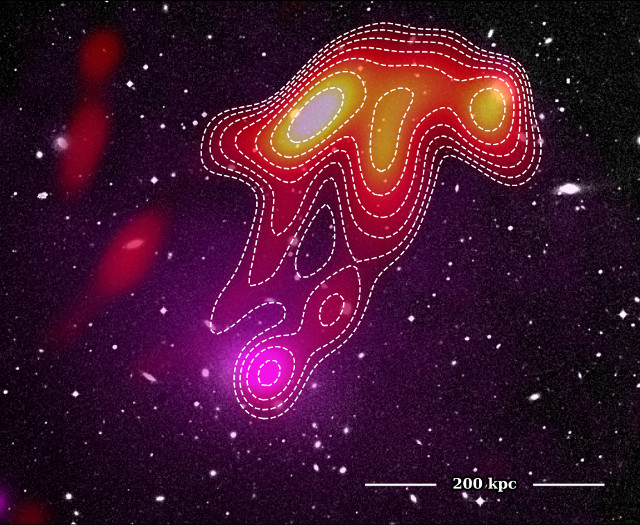
An article published in “The Astrophysical Journal” reports a study on the galaxy cluster Abell 2877 conducted with the MWA radio telescope which identified a plasma cloud with a shape similar to a jellyfish. A team led by Torrance Hodgson of the International Center for Radio Astronomy Research (ICRAR) observed Abell 2877 at different radio frequencies and, when they turned the frequency down, they discovered that cosmic structure visible for a short time and only at very few frequencies. It could be plasma ejected about two billion years ago from supermassive black holes in different galaxies that mixed just as shockwaves passed through the cluster, reigniting the plasma for a period that is very short from an astronomical point of view.
This cosmic cloud appears from the Earth with a size that is over a third of the Moon’s and first appeared in the GLEAM (GaLactic and Extragalactic All-sky MWA) survey conducted with the MWA (Murchison Widefield Array) radio telescope, a precursor of the SKA, the next-generation radio telescope. Franco Vazza of the University of Bologna and associate of the Italian National Institute of Astrophysics, one of the authors of the study, explained that it has an ultra-steep spectrum, which means it has a much higher emission at low frequencies than at high ones. This and its particular shape led the researchers to observe the same area for a longer time exploiting the upgrade to the MWA that was carried out in the meantime.
The image (Torrance Hodgson, ICRAR/Curtin University) shows a composition with the jellyfish-like structure in the Abell 2877 galaxy cluster shown in red/yellow at a frequency of 118 MHz with optical frequency data from the Digitalized Sky Survey in the background and X-ray data detected by the XMM-Newton space telescope in magenta.
That sort of cosmic jellyfish formed by plasma is out of the ordinary because it’s visible only at certain frequencies in the FM radio band but already disappears at 200 MHz. That’s because the emissions fall with increasing frequencies, while in known sources the decrease in emissions is much slower. This indicates that the electrons emitting radio waves are accelerated by a very inefficient process in a very short phase of activity detected by chance.
The researchers created computer simulations to try to explain the nature of that cosmic jellyfish. The results suggest that electrons emitted about 200 million years earlier by two radio galaxies in the Abell 2877 cluster mixed and were crossed by a shock wave.
The formation of the structure probably dates back much earlier, perhaps two billion years ago. Supermassive black holes in some galaxies in the Abell 2877 cluster emitted powerful jets of plasma which remained inert until mixed and at the same time got struck by the shock waves that passed through Abell 2877. This is a phenomenon with a very short life from an astronomical point of view and which was detected only by chance thanks to a sensitive instrument such as the MWA radio telescope, built to develop new technologies that will be used in the SKA project.
The SKA radio telescope will be thousands of times more sensitive than its precursor MWA and will have a much higher resolution, so it will be used to study the structure of Abell 2877 and other transient phenomena that can only be detected under particular conditions. Ambitious projects like SKA are being developed precisely to see where there seemed to be nothing of interest.

